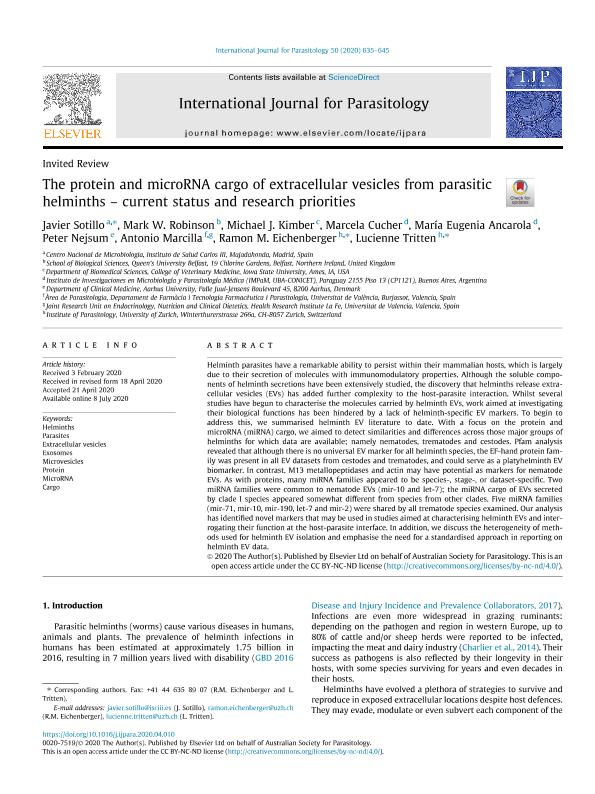Mostrar el registro sencillo del ítem
dc.contributor.author
Sotillo, Javier
dc.contributor.author
Robinson, Mark W.
dc.contributor.author
Kimber, Michael J.
dc.contributor.author
Cucher, Marcela Alejandra

dc.contributor.author
Ancarola, María Eugenia

dc.contributor.author
Nejsum, Peter
dc.contributor.author
Marcilla, Antonio
dc.contributor.author
Eichenberger, Ramon M.
dc.contributor.author
Tritten, Lucienne
dc.date.available
2021-10-06T11:22:48Z
dc.date.issued
2020-08
dc.identifier.citation
Sotillo, Javier; Robinson, Mark W.; Kimber, Michael J.; Cucher, Marcela Alejandra; Ancarola, María Eugenia; et al.; The protein and microRNA cargo of extracellular vesicles from parasitic helminths – current status and research priorities; Elsevier; International Journal for Parasitology; 50; 9; 8-2020; 635-645
dc.identifier.issn
0020-7519
dc.identifier.uri
http://hdl.handle.net/11336/142812
dc.description.abstract
Helminth parasites have a remarkable ability to persist within their mammalian hosts, which is largely due to their secretion of molecules with immunomodulatory properties. Although the soluble components of helminth secretions have been extensively studied, the discovery that helminths release extracellular vesicles (EVs) has added further complexity to the host-parasite interaction. Whilst several studies have begun to characterise the molecules carried by helminth EVs, work aimed at investigating their biological functions has been hindered by a lack of helminth-specific EV markers. To begin to address this, we summarised helminth EV literature to date. With a focus on the protein and microRNA (miRNA) cargo, we aimed to detect similarities and differences across those major groups of helminths for which data are available; namely nematodes, trematodes and cestodes. Pfam analysis revealed that although there is no universal EV marker for all helminth species, the EF-hand protein family was present in all EV datasets from cestodes and trematodes, and could serve as a platyhelminth EV biomarker. In contrast, M13 metallopeptidases and actin may have potential as markers for nematode EVs. As with proteins, many miRNA families appeared to be species-, stage-, or dataset-specific. Two miRNA families were common to nematode EVs (mir-10 and let-7); the miRNA cargo of EVs secreted by clade I species appeared somewhat different from species from other clades. Five miRNA families (mir-71, mir-10, mir-190, let-7 and mir-2) were shared by all trematode species examined. Our analysis has identified novel markers that may be used in studies aimed at characterising helminth EVs and interrogating their function at the host-parasite interface. In addition, we discuss the heterogeneity of methods used for helminth EV isolation and emphasise the need for a standardised approach in reporting on helminth EV data.
dc.format
application/pdf
dc.language.iso
eng
dc.publisher
Elsevier

dc.rights
info:eu-repo/semantics/openAccess
dc.rights.uri
https://creativecommons.org/licenses/by-nc-nd/2.5/ar/
dc.subject
CARGO
dc.subject
EXOSOMES
dc.subject
EXTRACELLULAR VESICLES
dc.subject
HELMINTHS
dc.subject
MICRORNA
dc.subject
MICROVESICLES
dc.subject
PARASITES
dc.subject
PROTEIN
dc.subject.classification
Bioquímica y Biología Molecular

dc.subject.classification
Ciencias Biológicas

dc.subject.classification
CIENCIAS NATURALES Y EXACTAS

dc.title
The protein and microRNA cargo of extracellular vesicles from parasitic helminths – current status and research priorities
dc.type
info:eu-repo/semantics/article
dc.type
info:ar-repo/semantics/artículo
dc.type
info:eu-repo/semantics/publishedVersion
dc.date.updated
2021-09-07T18:53:30Z
dc.journal.volume
50
dc.journal.number
9
dc.journal.pagination
635-645
dc.journal.pais
Países Bajos

dc.journal.ciudad
Amsterdam
dc.description.fil
Fil: Sotillo, Javier. Instituto de Salud Carlos Iii (isciii); España
dc.description.fil
Fil: Robinson, Mark W.. The Queens University of Belfast; Irlanda
dc.description.fil
Fil: Kimber, Michael J.. Queen’s University ; Reino Unido
dc.description.fil
Fil: Cucher, Marcela Alejandra. Consejo Nacional de Investigaciones Científicas y Técnicas. Oficina de Coordinación Administrativa Houssay. Instituto de Investigaciones en Microbiología y Parasitología Médica. Universidad de Buenos Aires. Facultad de Medicina. Instituto de Investigaciones en Microbiología y Parasitología Médica; Argentina
dc.description.fil
Fil: Ancarola, María Eugenia. Consejo Nacional de Investigaciones Científicas y Técnicas. Oficina de Coordinación Administrativa Houssay. Instituto de Investigaciones en Microbiología y Parasitología Médica. Universidad de Buenos Aires. Facultad de Medicina. Instituto de Investigaciones en Microbiología y Parasitología Médica; Argentina
dc.description.fil
Fil: Nejsum, Peter. Aarhus University. Aarhus Institute Of Advanced Studies.; Dinamarca
dc.description.fil
Fil: Marcilla, Antonio. Universidad de Valencia; España
dc.description.fil
Fil: Eichenberger, Ramon M.. Universitat Zurich; Suiza
dc.description.fil
Fil: Tritten, Lucienne. Universitat Zurich; Suiza
dc.journal.title
International Journal for Parasitology

dc.relation.alternativeid
info:eu-repo/semantics/altIdentifier/doi/http://dx.doi.org/10.1016/j.ijpara.2020.04.010
dc.relation.alternativeid
info:eu-repo/semantics/altIdentifier/url/https://www.sciencedirect.com/science/article/pii/S0020751920301612?via%3Dihub
Archivos asociados
